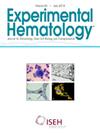BST2 facilitates activation of hematopoietic stem cells through ERK signaling
IF 2.5
4区 医学
Q2 HEMATOLOGY
引用次数: 0
Abstract
The proinflammatory cytokine interferon gamma (IFNγ) is upregulated in a variety of infections and contributes to bone marrow failure through hematopoietic stem cell (HSC) activation and subsequent exhaustion. The cell-surface protein, bone marrow stromal antigen 2 (BST2), is a key mediator of this process, because it is induced upon IFN stimulation and required for IFN-dependent HSC activation. To identify the mechanism by which BST2 promotes IFN-dependent HSC activation, we evaluated its role in niche localization, immune cell function, lipid raft formation, and intracellular signaling. Our studies indicated that knockout (KO) of BST2 in a murine model does not disrupt immune cell responses to IFN-inducing mycobacterial infection. Furthermore, intravital imaging studies indicate that BST2 KO does not disrupt localization of HSCs relative to endothelial or osteoblastic niches in the bone marrow. However, using imaging-based flow cytometry, we found that IFNγ treatment shifts the lipid raft polarity of wild-type (WT) but not Bst2−/− hematopoietic stem and progenitor cells (HSPCs). Furthermore, RNAseq analysis, reverse-phase protein array and western blot analysis of HSPCs indicate that BST2 promotes ERK1/2 phosphorylation during IFNγ-mediated stress. Overall, we find that BST2 facilitates HSC division by promoting cell polarization and ERK activation, thus elucidating a key mechanism of IFN-dependent HSPC activation. These findings inform future approaches in the treatment of cancer and bone marrow failure.
BST2 通过 ERK 信号促进造血干细胞的活化
促炎细胞因子γ干扰素(IFNγ)在多种感染中上调,并通过造血干细胞(HSC)激活和随后的衰竭导致骨髓衰竭。细胞表面蛋白骨髓基质抗原2(BST2)是这一过程的关键介质,因为它在干扰素刺激下被诱导,并且是干扰素依赖性造血干细胞活化所必需的。为了确定 BST2 促进干扰素依赖性造血干细胞活化的机制,我们评估了它在龛定位、免疫细胞功能、脂筏形成和细胞内信号传导中的作用。我们的研究表明,在小鼠模型中敲除(KO)BST2 不会破坏免疫细胞对干扰素诱导的分枝杆菌感染的反应。此外,体内成像研究表明,BST2 KO 不会破坏造血干细胞在骨髓中相对于内皮或成骨细胞龛的定位。然而,利用基于成像的流式细胞术,我们发现 IFNγ 处理会改变 WT 造血干细胞和祖细胞(HSPCs)的脂筏极性,但不会改变 Bst2-/-造血干细胞和祖细胞(HSPCs)的脂筏极性。此外,HSPCs 的 RNAseq 分析、反相蛋白阵列和 Western 印迹分析表明,在 IFNγ 介导的应激过程中,BST2 可促进 ERK1/2 磷酸化。总之,我们发现 BST2 通过促进细胞极化和 ERK 激活来促进造血干细胞分裂,从而阐明了干扰素依赖性 HSPC 激活的关键机制。这些发现为未来治疗癌症和骨髓衰竭提供了参考。
本文章由计算机程序翻译,如有差异,请以英文原文为准。
求助全文
约1分钟内获得全文
求助全文
来源期刊

Experimental hematology
医学-血液学
CiteScore
5.30
自引率
0.00%
发文量
84
审稿时长
58 days
期刊介绍:
Experimental Hematology publishes new findings, methodologies, reviews and perspectives in all areas of hematology and immune cell formation on a monthly basis that may include Special Issues on particular topics of current interest. The overall goal is to report new insights into how normal blood cells are produced, how their production is normally regulated, mechanisms that contribute to hematological diseases and new approaches to their treatment. Specific topics may include relevant developmental and aging processes, stem cell biology, analyses of intrinsic and extrinsic regulatory mechanisms, in vitro behavior of primary cells, clonal tracking, molecular and omics analyses, metabolism, epigenetics, bioengineering approaches, studies in model organisms, novel clinical observations, transplantation biology and new therapeutic avenues.
 求助内容:
求助内容: 应助结果提醒方式:
应助结果提醒方式:


